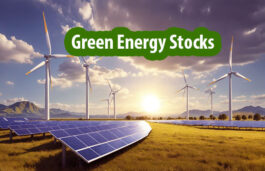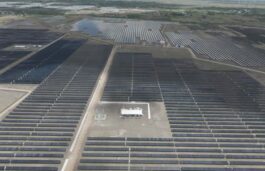

The technology chapter of solar energy is aerobicized, the growing efficiencies and advance solar cells is aggrandizing operation regardless of robust conditions. In the case of India, the valiant figures of solar integration are extolling and cementing new charts of growth. This unequivocally qualifies the international and national players to proliferate and also aggressively dive into to new benchmarks in the rampant low-solar power bids. As of 6 April 2017, the country’s solar grid had a cumulative capacity of 12.28 GW. India quadrupled its solar-generation capacity from 2,650 MW on 26 May 2014 to 12,289 MW on 31 March 2017. Flushing the Internet in recent times, is the constructive stories and articles of the drastic falls of solar tariffs. With recent GST taxation provisions, scuttle-butting and weening on the dramatic low tariffs will be hankering for the Indian solar industry.
Cut-Throat Solar Bids, The Trend-Setter
From July 2015 to December 2016, developers in India have snapped up contracts to set up 15.9 GW of solar projects. Of these, as much as 3.275 GW have been won by quoting tariffs below Rs 4 per unit of electricity. Noting to variable media houses, experts say the downward slide of solar tariffs will have far reaching implications for electricity from other sources in India. In just a term of three months, the economics of falling bids have highbrowed. Solar power developers bid went as low as Rs2.97 per kilowatt hour (kWh) for a 750-megawatt (MW) project at Rewa in Madhya Pradesh. The winning bid offered a so-called levelized tariff—the value financially equivalent to different annual tariffs over the period of the power purchase agreement (PPA)—of around Rs3.30 per unit. To break the plunging ice of lowest bids, Phelan Energy Group and Avaada Power Private Limited have bagged 100 MW and 50 MW solar power project respectively at Rs 2.62 per unit, and SBG Cleantech managed to obtain 100 MW at Rs 2.63 a unit for Bhadla Phase IV 250 MW solar project. Further, Rajasthan Bhadla Phase-III Solar Park went going lower witnessing tariff of Rs. 2.44 per unit discovered in the auction for 500 MW capacity. Does ‘Low’ Solar Bids Equals ‘Low’ IRR? Tariffs in the solar space have declined significantly over the years and have come down from levels in excess of Rs10 per kWh at the beginning of this decade to the present record lows, as capacity is being added at a record pace. Some speculations from the industry experts assert that these falling bid rates of solar power can hurt the IRR of solar power developers.
In an extensive exchange of conversation through an e-interaction, Alok Verma, AVP – Regulatory, Amplus Energy Solutions, said,

Alok Verma, AVP – Regulatory, Amplus Energy Solutions
The impact on IRRs has to be understood contextually. Way back, when project were signed under the Gujarat policy, IRRs spiked due to steep reduction in capital costs. Last year, winners saw a bump due to another steep correction in module prices. With this background, developers may be in for tighter times since they seem to be baking in aggressive forecasts, mostly on module prices but on factors which were considered untouchable, eg. USD /INR exchange rates. The outcome, as we all know, is uncertain. It always is, but as we see more aggressive bidding, smaller events may have higher impacts. If I were to pick up two assumptions, I would pick up module prices and continued availability of funding. Say, China rolls out a new policy for ground mounts or US changes its mind. This would change the module prices and we may not see the declines that we are expecting. On financing, the moment a project goes belly up, we will see lenders moving out of the sector and as we have seen it in the past, be it biomass projects in 2003-04 or thermal plants more recently, sectors become pariah enmasse.

Simarpreet Singh | Head | Strategy | Hartek Group
While elaborating on the falling solar price bid rates, and developers stance on this competitive season, Simarpreet Singh, Head, Strategy, Hartek Group, said,
with so many private players entering the solar sector and so much money chasing the industry, the competition is becoming more and more intense. So, developers have no choice but to pick up whatever project they can lay their hands on. A recent report by Deutsche Bank has pointed out that developers might have an issue servicing the debt at these rates, leave alone equity returns. Considering the huge capital available in the market for these projects, it is the cost of finance which holds the key. If developers can work out sustainable business models, it will be a win-win situation for all.
Falling Bid Rates, A Strain Strategy of Government’s 100 GW Dream
The government has set an ambitious target of attaining 100 GW of solar power capacity by 2022. Consequently, the total installed capacity in this space has gone up by over three times in the last three years. According to government data, the share of renewable energy in the total installed capacity was 13% at the end of financial year 2016. But it is expected to increase significantly in the coming years, with solar a big driver.
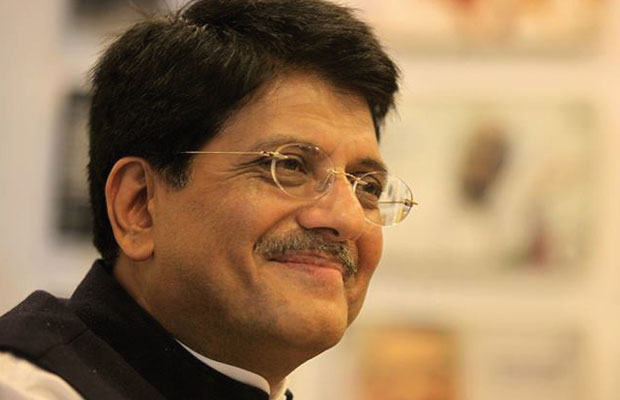
Alok Verma, AVP – Regulatory, Amplus Energy solutions, quotes both the earlier MP bid and the entire solar park structure is a good strategy considering that the developers are insulated from project development risks, i.e, land and ROW for transmission. Once inside the solar park, it is broadly the same, be it in India or abroad, from an implementation perspective. But while this strategy will ensure GWs, whether it will ensure MUs for 25 years, has a degree of uncertainty. This is left to investors and lenders.
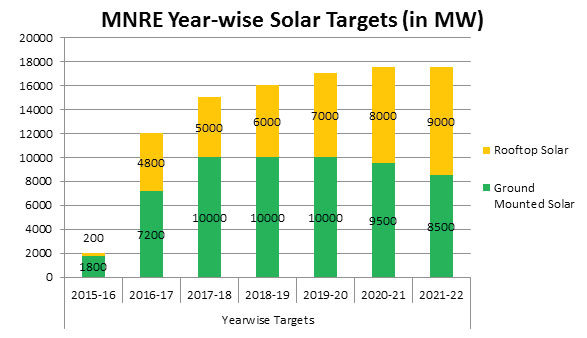
With the solar park concept, Government has given comfort to developers as well as lenders to remove the contingency (roughly 5 cents/Wp) and brought a level playing field to compete. Solar power parks reduce the expenses of infrastructure and eliminate two major risks – land acquisition and evacuation process. Absolutely! The solar sector has been growing at an unprecedented pace over the past couple of years, the credit for which goes to the Central government, particularly Power Minister Piyush Goyal, who attracted private players with competitive financing and created a healthy competition. But as we inch closer to the 100-GW target, we should see to it that the transmission system grows in sync with the increase in solar power generation. After all, grid infrastructure is the missing link in India’s solar chain, affirms Simarpreet Singh, Head, Strategy, Hartek Group.
The Fancy Run of Indian Solar Industry Behind Cheap Bids Government of India’s liberal financial schemes, availability of finance are also duly becoming a backbone for the pragmatic solar industry. State-owned power producer NTPC Ltd appropriately summed up the progress in the sector in a recent press statement: “At current rates, solar power generation cost is at par with that of thermal power generation. Solar power tariff has been declining on account of sharply declining prices of solar panels, better structuring of the project that reduces risk for project developers and better currency hedging deals that make financing available at competitive cost.”
Whereas, Alok Verma, AVP – Regulatory, Amplus Energy Solutions, cites:
- No project development risks, eg. land and evacuation
- No evacuation infrastructure
- Falling prices of modules
- Reduction in BOS prices
- Solar Park concept by Government and related incentives
- Longer financing with refinancing assumptions, thereby making loans even longer
- Flat or appreciating INR
- Low O&M costs
Simarpreet Singh, Head, Strategy, Hartek Group, feels, the government has done well by creating a conducive environment to ensure accelerated growth of the solar industry by attracting huge private investments. With solar project auctions attracting so many bidders, the sector is becoming increasingly competitive, leading to lower tariffs. Solar tariffs have come down by 40-45% in the past 18 months or so owing to an appreciable drop in the cost of equipment as well as the cost of finance. But we should also bear in mind that the lower tariffs apply largely to solar parks where developers don’t have to pay for the cost of land and grid transmission and evacuation.
Is it the Way Towards Adoption of Captive Solar Power Generation and Save on the Cross-Subsidy Component?
The fall in solar power generation cost has now made it attractive for businesses to go for captive solar power plants, including rooftop plants that supply power cheaper than from the grid, which is expensive on account of the cross-subsidy that industrial consumers are saddled with. Businesses, especially in the manufacturing sector, have long been complaining of high cost of power, exorbitant tax on diesel and escalating cost of capital as factors that render them less competitive in global markets where their peers enjoy low or negative cost of capital and in some cases, subsidies.
Private PPAs for the industry can be done under the third party sale or captive model, the latter requiring investment by the off taker in the power plant. However, since C & I customers are a Discom’s cream and they help the Discom serve other categories, viz., residential and agricultural, Discoms do not encourage policies that allow their paying customers to leave. Benefit of falling prices and a surge in captive plants would depend on the state policies on wheeling charges and banking. Most of the states have RE policies that provide exemptions or benefits for 5-10 years. This results in PPAs of similar tenors. We can see tariffs similar to the recent utility sale bid only if all factors are same, eg. tenor of PPAs, and hence tenor of financing available for private PPAs, scale of projects (private PPAs vary between 1-20 MW while utility bids are ~ 100 – 500 MW), project development risks, eg. land and evacuation, apprise Alok Verma, AVP – Regulatory, Amplus Energy solutions.
We believe that captive solar power generation by commercial buildings and industries through rooftop solar plants is the way forward. It will help create a truly sustainable ecosystem. To tap the immense rooftop potential, we, at Hartek Group, recently embarked on Hartek Solar, our new rooftop solar business vertical which will come up with micro grids to evacuate captive solar power and devise innovative solutions and attractive business models to capitalise on emerging trends, said Simarpreet Singh, Head, Strategy, Hartek Group.
The Economics of Future Low-Solar Power Bids
A year ago few analysts said that power companies have to fulfill their Renewable Purchase Obligation (RPO) under Electricity Act, 2003 adapted in 2010 as a part of NAPCC, so they have to invest and hence ply with the bidding competition. According to analysts, interest rates may fall by at least 25 basis points this year.
Alok Verma, AVP – Regulatory, Amplus Energy solutions, envisions, the prices have been decreasing in the past few quarters and have already reached the sustainability border at the current manufacturing regime. To see a further decline in prices, manufacturers need to enhance the manufacturing and operational efficiency. Secondly, if government further supports solar power generation through its incentives and policies, the prices can affect accordingly.
Emphasizing on its company’s role, Simarpreet Singh, Head, Strategy, Hartek Group, said, it is a wait and watch game. Any further drop in prices will depend more on the cost of finance rather than the cost of technology. Having connected close to 600 MW of solar power to the grid, we at Hartek Group believe that EPC companies should not deviate from quality in their eagerness to execute more projects than they can practically handle. After all, these projects have to last a good 25 years.
The Long-Run Investment Risk
Low tariff bids at recent solar projects could prove risky for developers, as the cost margin could dent the operational margins. But extensively, the solar business has been on the risk-view but has delivered on over the mark basis. Despite niggling concerns on squeezed bottom-lines, investments are pouring into India’s renewables sector. Total corporate funding into the solar sector alone, which includes venture capital funding, public market and debt financing, doubled to $3.2 billion in the first quarter of 2017 compared with $1.6 billion in the three months ended on 31 December, according to the latest report by Mercom Capital Group.
Year-over-year funding in the March quarter was about 15% higher compared with the $2.8 billion raised in the first quarter of 2016, the energy consultancy firm said.

Sharing a pragmatic vision on the long-run of this low-bid trend, Alok Verma, AVP – Regulatory, Amplus Energy solutions, added, The first victim of aggressive bidding is the redundancy in capital equipment. Of late, we have seen the market consider minimum redundancies on electrical infrastructure. From earlier designs, where it would be ensured that power flows from an inverter block, even in case of a cable fault, today we have cut short the infrastructure. This may lead to complete shutdown of the inverter block in case of a cable failure. We have also seen the weight of structures go down. While this may be credited to better designs, it also leaves little room for construction tolerances. We are sure that developers would be taking adequate measures for pre-dispatch and field quality inspections. However, as we all know, translating a design to construction to operations is not exact and any over optimization can lead to failures, which would otherwise not have been accounted while bidding.
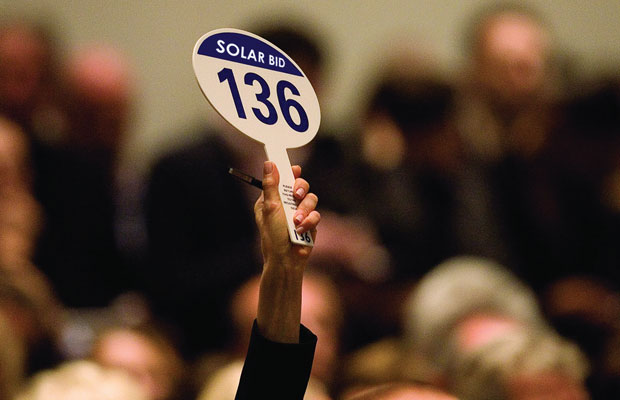
Simarpreet Singh, Head, Strategy, Hartek Group, concludes, pertinently, there are no variable costs for the ultra mega solar projects which have witnessed lower tariffs. The only cost for the developer is the interest he has to pay after the commissioning. With interest rates going down, these projects are expected to become increasingly viable for developers. We have to ensure that these solar plants run efficiently for their entire life span of 25 years, for which we cannot afford to have any compromise on quality and workmanship. Having set up substations for nearly 600-MW solar projects, we cannot overemphasise the role of quality of design and construction in maintaining the efficiency of solar plants.


